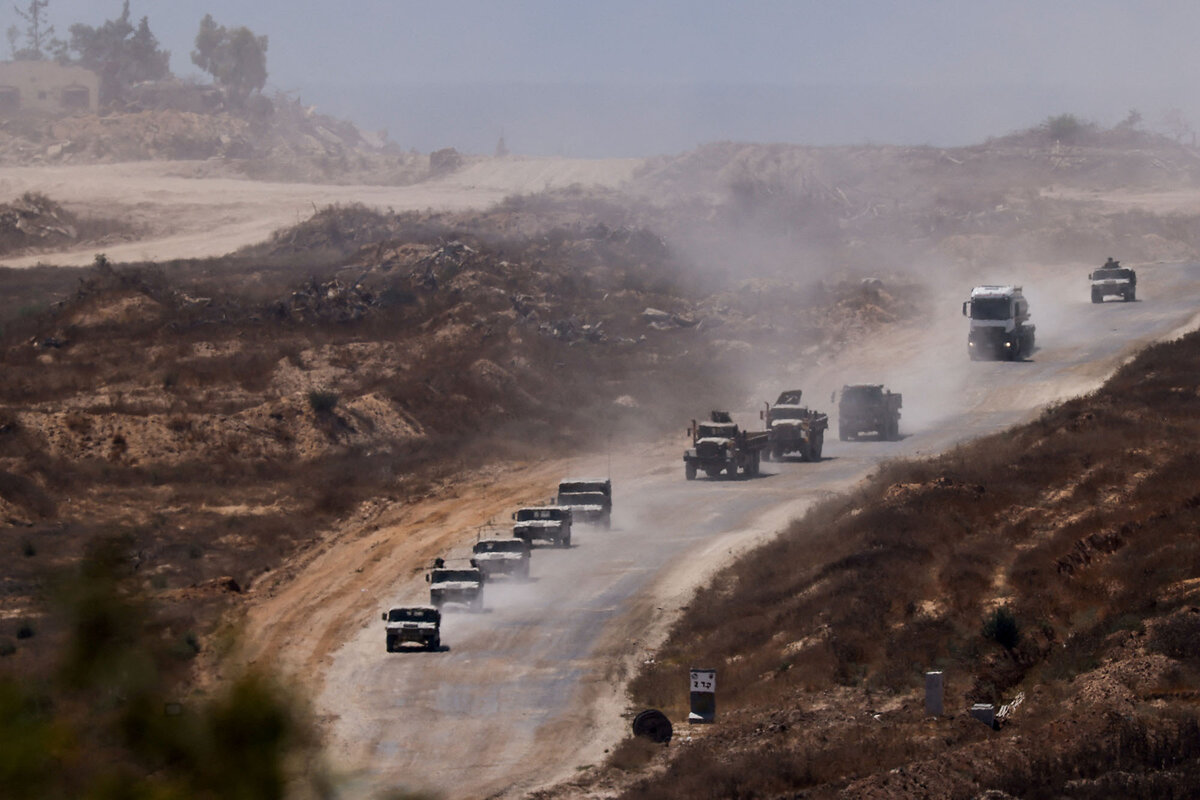When does self-defense cross a line? Outcry over Israel in Gaza mounts.
| London
It is a jarringly impersonal term for a life-and-death issue at the heart of the eight-month war in Gaza: whether Israel has exercised proportionality in its military response to Hamas’ spate of killings and kidnappings last Oct. 7.
The reason for the international focus on this bedrock international legal principle is clear: the immense toll being borne by Gaza’s Palestinian civilian population in the fighting.
Still, applying it to the Israel-Hamas conflict is less straightforward.
Why We Wrote This
How heavy do civilian casualties have to get before they are judged too severe to justify? Israel is finding it hard to explain to the world its tactics in Gaza.
That’s because it requires disentangling a web of issues every bit as complex as the Israeli-Palestinian conflict itself – not just human and ethical, but also regarding matters of politics, military decisions, and the international rules of warfare.
One thing is straightforward.
While there has been terrible suffering on both sides, the scale of physical destruction, and the number of civilian casualties, have been far greater in Gaza. So, too, is the number of people forced from their homes and now facing shortages of vital supplies.
The numerical imbalance was brought home again this month, when Israeli special forces rescued four of the dozens of hostages still held by Hamas, from a pair of civilian apartment buildings. Although the rescue operation initially took the captors by surprise, Israel’s ground and air response during an ensuing firefight claimed more than 200 lives.
Yet the international agreements underpinning “proportionality” make it clear that the rights and wrongs of war cannot be reduced to a mere head count of the victims on each side.
That is especially true of wars like that in Gaza – and other 21st century conflicts, like the United States’ “war on terror” after the Al Qaeda attack of 9/11. Such confrontations have pitted a militarily dominant country against nonstate adversaries embedded among civilians and subscribing to very different rules of engagement, or no rules at all.
One man’s proportionality ...
Proportionality, in the body of humanitarian law governing the treatment of civilians in wartime, is defined differently.
It requires, first, that in the kind of “war of self-defense” that Israel launched after Oct. 7, decision-makers must not use more force than is necessary to defeat the threat they are facing.
During combat, an additional protocol to the Geneva Conventions stipulates that “an attack shall be cancelled or suspended if it becomes apparent … that the attack may be expected to cause incidental loss of civilian life, injury to civilians, damage to civilian objects, or a combination thereof, which would be excessive in relation to the concrete and direct military advantage anticipated.”
So, overall, has Israel been meeting those tests?
“No” is the verdict – and not only from Hamas and other pro-Palestinian voices.
Similar accusations have come from Russia and China, from human-rights groups, and from some U.S. allies in Europe. Even Israel’s most important international ally, U.S. President Joe Biden, has described some aspects of Israeli actions in Gaza as “over the top.”
Israel, however, has strongly rebutted the allegations.
Israeli leaders say the unprecedented scale of their attacks in Gaza was a necessary and proportionate response to Hamas’ Oct. 7 massacre – the greatest loss of Jewish life in a single day since the Nazi Holocaust.
From the outset, Prime Minister Benjamin Netanyahu said Israel was launching something very different from the more limited military operations it has pursued in Gaza in the past.
Those were aimed at curbing Hamas rocket fire for a few years. This would be an all-out “war,” aimed at permanently breaking Hamas’ hold on Gaza and destroying its capacity to threaten Israel.
Israeli officials have also pushed back against accusations they have been waging that war with disproportionate force and insufficient attention to civilian lives. They have emphasized the occasions on which Israeli planes dropped leaflets warning local residents of impending attack.
They have not seriously challenged the high number of deaths in Gaza – at nearly 40,000, many times more than the roughly 1,500 Israeli lives lost.
But they do take issue with Palestinian assertions, widely accepted by the world’s media, that the great majority of the victims in Gaza have been civilians, women, and children. Israel’s argument has been boosted by a recent shift in the U.N.’s assessment of the casualty figures and reports suggesting many of the victims have, in fact, been men of fighting age.
What do the Talmud and Quran say?
Which of the dueling views about the war is more accurate will become clear, if at all, only after the fighting is over. And that is not only because they are part of the wider argument over the rights and wrongs of the Israeli-Palestinian conflict.
It is because the tests of proportionality under international law are inherently subjective.
Ultimately, they come down to the weight that decision-makers place on civilian lives. The single greatest hurdle to an eventual peace is the degree to which Israelis and Palestinians value – or do not value – each others’ common humanity.
Hamas leaders have so far given little sign of valuing civilian lives. The Oct. 7 attacks targeted young and old, women and children, and, as the war has ground on, they appear to view the plight of Palestinian civilians with little more regard.
They have reserved their vast network of protective underground tunnels in Gaza for Hamas fighters. And news reports this month cited Hamas’ military commander, Yehia Sinwar, as calling Palestinian deaths a “necessary sacrifice” in its struggle against Israel.
While Israel’s Prime Minister Netanyahu has insisted his commanders are properly taking the risk to Gaza’s civilians into account, other Israeli officials since Oct. 7 have denigrated Palestinians as “animals.”
Maybe the hope for change, however distant, could lie in a source that leaders on both sides of the war in Gaza profess to cherish: their religious texts.
Both the Jewish Talmud and the Quran teach a powerful ethical lesson.
In a verse echoed verbatim in the Quran, the Talmud says that “whoever destroys a single soul, Scripture regards him as if he had destroyed a complete world.
“And whoever preserves a single soul, Scripture regards him as if he had preserved a complete world.”








